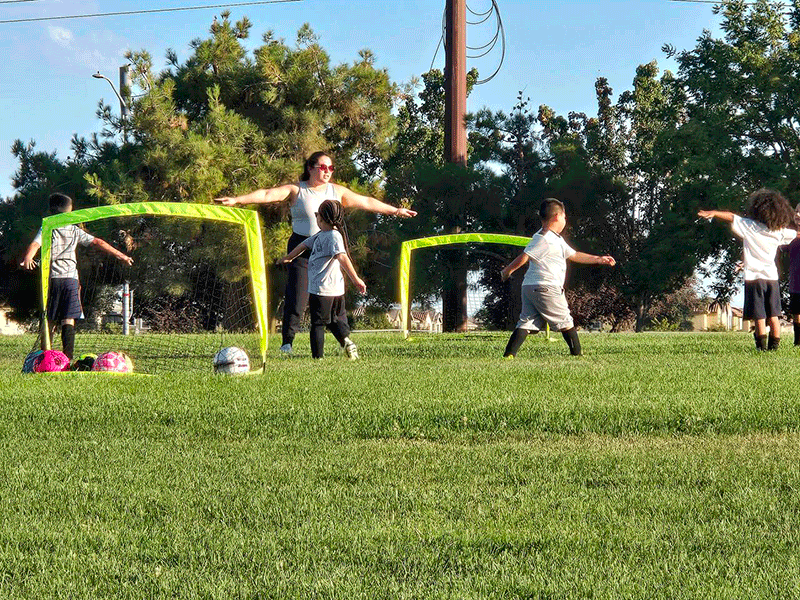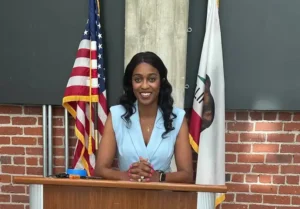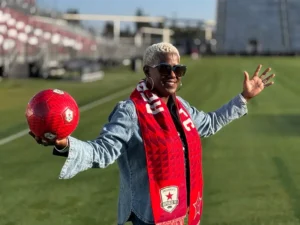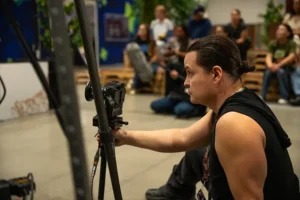Access to capital is often described as the lifeblood of business, yet for many entrepreneurs—especially those from immigrant, refugee, and underserved communities—navigating the financial system can feel overwhelming. Few people understand this challenge better than Marie Judith Fleming, a business strategist and the CEO of Gold Bridge Capital Solutions. With decades of experience advising entrepreneurs on financing strategies, credit readiness, and project development, Marie has become a trusted advocate for equitable access to opportunity.

In her work with Pacific Community Ventures (PCV) and as an Ambassador to the Natomas Chamber of Commerce, she builds bridges between employers, lenders, and service organizations, creating pathways to education, jobs, and entrepreneurship. Now, as she steps into her new role as Treasurer of the Council for Cross-Cultural Affairs, Inc., Marie is bringing her expertise in governance, finance oversight, and community outreach to strengthen the mission of empowering diverse communities.
In this exclusive conversation with New Times Magazine publisher Sergey Ivannikov, Marie shares her insights on small business resilience, financial literacy, and what it truly takes to level the playing field for entrepreneurs of all backgrounds.
Marie, what inspired you to focus your career on helping entrepreneurs gain access to capital and financial resources?
From the time I opened my commercial real estate firm, I noticed a pattern. People would come in wanting to acquire a property or buy the building they were leasing, but there was a whole class of business owners who were underserved. When they approached lenders, they weren’t guided or supported—they were simply told “no.” No explanation, no hand-holding, no pathway forward.
That’s when I saw the need right away. I kept meeting hardworking entrepreneurs—immigrants, minorities, small business owners—who had incredible ideas and the drive to succeed, but they were completely overwhelmed by the financial system. It wasn’t a lack of ambition holding them back; it was the lack of access and guidance.
I thought, if I can help bridge that gap—if I can be the one to sit with them, walk them through the process, and show them a way forward—their businesses will grow, their families will thrive, and their communities will benefit too. That realization became my “why,” and it’s what continues to drive my work today.
In your experience, what are the most common challenges that small business owners face when trying to secure funding?
Honestly, the biggest challenge is that most people don’t know where to start. Do they have the right down payment? Do they have the assets lenders are going to require? Is their business structured in a way that supports growth or expansion? These are all valuable questions, but many entrepreneurs don’t even know they should be asking them.
On top of that, there’s the preparation piece—getting financial documents in order, making sure credit is in good shape, and having a business plan that gives lenders confidence. Without that, it’s easy for a bank to say no.
That’s why education is so important. When you can sit down with someone, walk them through a plan that makes sense, and show them what steps to take, it builds confidence and trust. And even if I’m not the one who ultimately funds them, being able to point them toward the right resource is still incredibly valuable. Sometimes just knowing who can help is enough to keep an entrepreneur moving forward.
How does Gold Bridge Capital Solutions address the specific needs of underserved and immigrant entrepreneurs?
We meet people where they are. Sometimes that means helping them clean up their books, sometimes it’s walking them through credit readiness, and other times it’s just listening and being a steady advocate. Even if someone can’t get funding today, we make sure they’re better prepared for tomorrow. It’s really about education and empowerment—building confidence as much as capital.

You also work with Pacific Community Ventures (PCV). How does this collaboration expand your ability to support small businesses?
PCV is incredible because it’s not just about lending money—it’s about surrounding business owners with the right support system. They connect entrepreneurs with mentors who can guide them on everything from marketing to operations to long-term growth. That combination of capital plus guidance is where real transformation happens.
I’ve also worked with the SBDC, which provides a similar function. There are times when I may not have the capital or the bandwidth to give an entrepreneur everything they need—maybe they need to build more skills, take a class, or spend time on training. Knowing that organizations like PCV and SBDC exist gives me a trusted place to send clients. It’s not just about what I can do directly—it’s about being part of a broader community of support that helps entrepreneurs succeed.
As an Ambassador to the Natomas Chamber of Commerce, how do you see chambers playing a role in bridging employers, lenders, and community resources?
Chambers are like community glue—they connect the dots. They bring together businesses, banks, nonprofits, and civic leaders who might not otherwise sit at the same table. When those connections happen, opportunities open up. I’ve seen entrepreneurs who were overlooked suddenly find doors opening because of a chamber introduction.
Financial literacy is often cited as a major barrier to success. What practical steps do you recommend for entrepreneurs to strengthen their financial readiness?
The first step is to start small and build good habits. Track every dollar that comes in and every dollar that goes out. It sounds simple, but many businesses lose control because they don’t have visibility into their cash flow. One of the biggest mistakes I see is mixing personal and business expenses—keeping those separate is absolutely critical.
As your business grows, learn how to read a profit-and-loss statement and a cash flow report. These aren’t just for accountants—these reports tell the story of your business. And if numbers aren’t your strength, that’s okay. Allocate your strengths wisely and hire a certified, experienced bookkeeper or accountant to handle your books. It’s an investment, not an expense, because you cannot qualify for business credit, buy a commercial building, or acquire another company without clean, accurate financials.
Get into the habit of doing this early—it’s much harder to fix later. And here’s something many business owners don’t like to hear but need to: it’s okay to take legitimate write-offs, but you must also show a profit and pay taxes. Lenders and investors want to see growth and strong net income. If you’re constantly showing losses to avoid taxes, you’re also showing you can’t afford to take on debt or grow. At the end of the day, strong books equal strong opportunities—and you will thank yourself later for putting those systems in place.
You’ve now taken on the role of Treasurer with the Council for Cross-Cultural Affairs, Inc. How do you see governance and finance oversight shaping the impact of nonprofit organizations?
Good governance is truly the backbone of any nonprofit. When finances are managed with transparency and integrity, donors and partners feel confident that their support is being put to its best use. For me, being Treasurer isn’t just about balancing numbers—it’s about stewardship. It’s about ensuring that every dollar entrusted to us is directed toward programs that empower the communities we serve.
I will serve this role with the same class and poise that the Council itself embodies. This organization represents dignity, cultural richness, and community leadership, and I intend for my financial stewardship to reflect those same values.
Beyond oversight, I believe the Treasurer’s role is to help the organization think long-term about sustainability.
That means creating clear financial reporting, building reserves where possible, and responsibly placing funds into safe, income-generating vehicles such as interest-bearing accounts or low-risk community investment opportunities. It also means encouraging diversified funding—whether through grants, donor partnerships, or matching campaigns—so the organization isn’t reliant on a single stream of income.
By marrying good governance with thoughtful financial strategy, we not only protect the integrity of the Council today but also ensure its ability to thrive for years to come.

You’re known for “wearing many hats” in your professional and community work. How do these roles complement one another?
They really do feed into each other. My consulting work gives me a front-row seat to the real struggles entrepreneurs face every day, from access to capital to scaling sustainably. My community roles keep me grounded in what families and neighborhoods truly need, beyond just the business side. And my governance work allows me to see the larger systems at play—how nonprofits, businesses, and civic organizations can align to create lasting impact.
At the core of all these roles is my belief in building community. Everything I do is about creating a path for fellow business owners, offering guidance and connection so they don’t have to walk alone. It’s also about blazing a trail that leaves a legacy for my family—showing that success isn’t measured only in financial terms but also in the friendships, networks, and trust we build along the way.
This balance between the day-to-day and the big picture, between business goals and human connections, is what makes my work meaningful. It’s not just about money—it’s about the people, the relationships, and the legacy of service that carries forward.
Which of your roles—CEO, strategist, ambassador, or treasurer—has been the most challenging, and why?
Being CEO, without a doubt. It’s like being the conductor of an orchestra; everyone around you is talented, but you need to understand enough about each role to keep the whole team in harmony. The responsibility is broad: setting the vision, making decisions that impact livelihoods, and constantly balancing risk with opportunity.
It’s challenging, but also the most rewarding role, because I get to create solutions from the ground up. I’m passionate about continuous learning, whether it’s from my team or from overcoming objections; every experience sharpens me. The role keeps me on my toes, and I wouldn’t have it any other way.
Partnership development is a major part of your expertise. What makes a partnership successful and sustainable in today’s economic climate?
A successful and sustainable partnership in today’s economic climate comes down to three things: alignment, transparency, and adaptability. Alignment means both sides share not just financial goals, but also values and a vision for long-term growth. Transparency builds trust—when challenges come up, open communication prevents small issues from becoming big fractures. And adaptability is critical right now; markets are shifting faster than ever, so partnerships that can pivot together will thrive.
As for today’s economic climate, it’s true that it matters because uncertainty and volatility are part of doing business right now. But at the same time, no matter what is happening in the economy, people are people. Trust, respect, and shared commitment remain the foundation. That’s why the strongest partnerships are those where each side sees the other not just as a transaction, but as a teammate invested in mutual success.
How do you balance the technical side of finance—budgets, reporting, internal controls—with the human side of empowering entrepreneurs and communities?
To me, they go hand in hand. The technical side creates stability and trust; the human side gives it purpose. Every spreadsheet I review, I remind myself—this isn’t just numbers. These are families, these are jobs, these are dreams. That perspective keeps me grounded.
Looking ahead, what is your vision for advancing access to capital and opportunity for low-income, refugee, and immigrant communities in California?
I want every entrepreneur to see a clear path to capital, no matter their background. That means more culturally responsive lenders, more education about credit and finance, and more wraparound support through community partnerships. It’s not enough to just give someone a loan—we need to give them the tools and guidance to succeed long-term.


You’ve also spoken about your dream projects, like developing a soccer training facility in Natomas. What inspired that idea, and why do you feel it’s important for the community?
My daughter played soccer until she was 15, so I’ve seen firsthand how the sport brings kids together, teaches teamwork, and creates lifelong friendships. In Natomas, we’re such a diverse community, and we don’t always have enough spaces where families can unite around a shared purpose. With the new complex being built in the area, there’s a real opportunity to build something that serves everyone—from professionals to the five-year-old just discovering his passion for the game.
For me, it’s not only about soccer—it’s about giving our community a place to belong, to grow, and to celebrate together.
How do community-based projects like the soccer training facility tie into your broader mission of economic empowerment and opportunity?
Community-based projects like a soccer field tie directly into my mission by bringing together the human side of opportunity with the hard numbers of economic impact. When you look at economic statistics—youth unemployment, educational gaps, and the lack of safe spaces for development—it’s clear that investments in community projects can move the needle in a meaningful way.
A soccer field isn’t just a place to play. It can become a pipeline for opportunity. Professional athletes can influence and inspire youth, showing them what’s possible when discipline and teamwork meet ambition. At the same time, local youth gain access to jobs that are often scarce—whether it’s through coaching, refereeing, maintenance, or helping organize events.
These projects can also weave in partnerships with local churches and schools, creating programs where students earn school credit, gain leadership experience, and build a pathway to college or a career. Imagine a high school student not only playing soccer but also helping run a tournament, learning event management, networking with mentors, and turning that into real-world experience. That’s empowerment in action.
What makes it powerful is the multiplier effect: you’re not just building a soccer field, you’re building community infrastructure. Businesses can sponsor teams, nonprofits can provide training, and families gain a safe, positive environment. All of this creates ripple effects that strengthen the local economy while giving young people the opportunity to prosper in ways they may not have imagined.
At the heart of it, a soccer field becomes a living example of how community, opportunity, and economic empowerment intersect.
Finally, what advice would you give to entrepreneurs and community leaders who are just starting their journey?
Know your “why.” That sense of purpose will carry you through the tough times. Don’t try to do it all alone—ask for help, build your support network, and lean on people who’ve been where you want to go. And take it step by step. Success usually comes from consistent, steady progress—not overnight leaps. I’ve only learned this the hard way.
*****
Marie Judith Fleming Contact:
CEO At Gold Bridge Capital Solutions | Creative CRE Financing | Business Sales Specialist | Business Consultant | Al & Sustainability Advocate


















